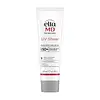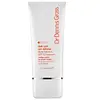What's inside
What's inside
 Key Ingredients
Key Ingredients

 Benefits
Benefits

 Concerns
Concerns

 Ingredients Side-by-side
Ingredients Side-by-side

Octocrylene 10%
UV AbsorberZinc Oxide 15%
Cosmetic ColorantWater
Skin ConditioningButyloctyl Salicylate
Skin ConditioningCoco-Caprylate/Caprate
EmollientIsohexadecane
EmollientButylene Glycol
HumectantIsododecane
EmollientPhenoxyethanol
PreservativePolyhydroxystearic Acid
EmulsifyingTriethoxycaprylylsilane
Polyacrylate Crosspolymer-6
Emulsion StabilisingAcacia Senegal Gum
MaskingPolysilicone-11
Xanthan Gum
EmulsifyingTetrahexyldecyl Ascorbate
AntioxidantEthylhexylglycerin
Skin ConditioningHydroxyethyl Acrylate/Sodium Acryloyldimethyl Taurate Copolymer
Emulsion StabilisingSqualane
EmollientDisodium EDTA
Polysorbate 60
EmulsifyingSodium Hyaluronate
HumectantSorbitan Isostearate
EmulsifyingOctocrylene 10%, Zinc Oxide 15%, Water, Butyloctyl Salicylate, Coco-Caprylate/Caprate, Isohexadecane, Butylene Glycol, Isododecane, Phenoxyethanol, Polyhydroxystearic Acid, Triethoxycaprylylsilane, Polyacrylate Crosspolymer-6, Acacia Senegal Gum, Polysilicone-11, Xanthan Gum, Tetrahexyldecyl Ascorbate, Ethylhexylglycerin, Hydroxyethyl Acrylate/Sodium Acryloyldimethyl Taurate Copolymer, Squalane, Disodium EDTA, Polysorbate 60, Sodium Hyaluronate, Sorbitan Isostearate
Titanium Dioxide
Cosmetic ColorantZinc Oxide
Cosmetic ColorantAcrylates/Carbamate Copolymer
Skin ConditioningAluminum Hydroxide
EmollientAscorbyl Glucoside
AntioxidantBenzyl Alcohol
PerfumingBHT
AntioxidantBis-Ethylhexyl Hydroxydimethoxy Benzylmalonate
AntioxidantBoerhavia Diffusa Root Extract
Skin ProtectingButylene Glycol
HumectantC12-15 Alkyl Benzoate
AntimicrobialCaprylyl Glycol
EmollientCarbomer
Emulsion StabilisingCarthamus Tinctorius Seed Oil
MaskingCitric Acid
BufferingCitrus Aurantium Dulcis Oil
MaskingCitrus Aurantium Dulcis Peel Extract
Emulsion StabilisingCoco-Caprylate/Caprate
EmollientCoconut Alkanes
EmollientDisodium EDTA
Echium Plantagineum Seed Oil
Skin ConditioningGlycerin
HumectantGlycolic Acid
BufferingHydrogenated Lecithin
EmulsifyingHydroxyethyl Acrylate/Sodium Acryloyldimethyl Taurate Copolymer
Emulsion StabilisingHydroxypropyl Cyclodextrin
MaskingIsohexadecane
EmollientIsononyl Isononanoate
EmollientIsopropyl Titanium Triisostearate
EmollientMagnesium Ascorbyl Phosphate
AntioxidantMelatonin
AntioxidantNordihydroguaiaretic Acid
AntioxidantOenothera Biennis Oil
EmollientOlea Europaea Fruit Oil
MaskingOleanolic Acid
Skin ConditioningOryza Sativa Extract
AbsorbentPalmitoyl Tripeptide-38
Skin ConditioningPEG-60 Almond Glycerides
EmulsifyingPentylene Glycol
Skin ConditioningPhenoxyethanol
PreservativePhospholipids
Skin ConditioningPolyhydroxystearic Acid
EmulsifyingPolysorbate 60
EmulsifyingPotassium Sorbate
PreservativePropanediol
SolventSaccharide Isomerate
HumectantSodium Benzoate
MaskingSodium Citrate
BufferingSodium Hyaluronate
HumectantSodium PCA
HumectantSphingolipids
EmollientStearic Acid
CleansingTetrahexyldecyl Ascorbate
AntioxidantTocopherol
AntioxidantWater
Skin ConditioningXanthan Gum
EmulsifyingZinc PCA
HumectantTitanium Dioxide, Zinc Oxide, Acrylates/Carbamate Copolymer, Aluminum Hydroxide, Ascorbyl Glucoside, Benzyl Alcohol, BHT, Bis-Ethylhexyl Hydroxydimethoxy Benzylmalonate, Boerhavia Diffusa Root Extract, Butylene Glycol, C12-15 Alkyl Benzoate, Caprylyl Glycol, Carbomer, Carthamus Tinctorius Seed Oil, Citric Acid, Citrus Aurantium Dulcis Oil, Citrus Aurantium Dulcis Peel Extract, Coco-Caprylate/Caprate, Coconut Alkanes, Disodium EDTA, Echium Plantagineum Seed Oil, Glycerin, Glycolic Acid, Hydrogenated Lecithin, Hydroxyethyl Acrylate/Sodium Acryloyldimethyl Taurate Copolymer, Hydroxypropyl Cyclodextrin, Isohexadecane, Isononyl Isononanoate, Isopropyl Titanium Triisostearate, Magnesium Ascorbyl Phosphate, Melatonin, Nordihydroguaiaretic Acid, Oenothera Biennis Oil, Olea Europaea Fruit Oil, Oleanolic Acid, Oryza Sativa Extract, Palmitoyl Tripeptide-38, PEG-60 Almond Glycerides, Pentylene Glycol, Phenoxyethanol, Phospholipids, Polyhydroxystearic Acid, Polysorbate 60, Potassium Sorbate, Propanediol, Saccharide Isomerate, Sodium Benzoate, Sodium Citrate, Sodium Hyaluronate, Sodium PCA, Sphingolipids, Stearic Acid, Tetrahexyldecyl Ascorbate, Tocopherol, Water, Xanthan Gum, Zinc PCA
 Reviews
Reviews

Ingredients Explained
These ingredients are found in both products.
Ingredients higher up in an ingredient list are typically present in a larger amount.
Butylene Glycol (or BG) is used within cosmetic products for a few different reasons:
Overall, Butylene Glycol is a safe and well-rounded ingredient that works well with other ingredients.
Though this ingredient works well with most skin types, some people with sensitive skin may experience a reaction such as allergic rashes, closed comedones, or itchiness.
Learn more about Butylene GlycolCoco-Caprylate/Caprate is created from fatty coconut alcohol, caprylic acid, and capric acid.
It is a lightweight emollient. Emollients create a thin barrier on the skin to trap moisture in. This helps keep your skin hydrated and soft.
Once applied, Coco-Caprylate/Caprate is absorbed quickly and leaves a silky feel.
Coco-Caprylate/Caprate may not be fungal acne safe.
Learn more about Coco-Caprylate/CaprateDisodium EDTA plays a role in making products more stable by aiding other preservatives.
It is a chelating agent, meaning it neutralizes metal ions that may be found in a product.
Disodium EDTA is a salt of edetic acid and is found to be safe in cosmetic ingredients.
Learn more about Disodium EDTAThis is a synthetic polymer. It helps improve the texture of products by adding thickness and gel-like feel.
It is also an emulsifer, meaning it prevents ingredients such as oil and water from separating. It also helps evenly disperse other ingredients.
Isohexadecane is added to enhance texture, emulsify, and to help cleanse. It is an isoparrafin. It is a component of petrolatum.
Due to its large size, Isohexadecane is not absorbed by the skin. Instead, it sits on top and acts as an emollient. Emollients help keep your skin soft and smooth by trapping moisture within.
Isohexadecane is often used in products designed to help oily skin. It is lightweight and non-greasy while helping to moisturize. When mixed with silicones, it gives a product a silky feel.
Learn more about IsohexadecanePhenoxyethanol is a preservative that has germicide, antimicrobial, and aromatic properties. Studies show that phenoxyethanol can prevent microbial growth. By itself, it has a scent that is similar to that of a rose.
It's often used in formulations along with Caprylyl Glycol to preserve the shelf life of products.
Polyhydroxystearic Acid is a soft wax made from castor oil.
It is is a texture thickener, emulsifier, and film-former. Emulsifiers prevent ingredients from separating, such as oils and waters.
Polyhydroxystearic Acid may not be fungal acne safe.
Learn more about Polyhydroxystearic AcidPolysorbate 60 is used to help stabilize products. It is a surfactant and emulsifier. These properties help keep ingredients together in a product. Surfactants help reduce surface tension between ingredients with different states, such as liquids and solids. Emulsifiers help prevent oils and waters from separating.
Polysorbate 60 is sorbitol-based and created from the ethoxylation of sorbitan. Ethoxylation is a chemical reaction used to add ethylene oxide. Sorbitan is a the dehydrated version of sorbitol, a sugar found in fruits.
In this case, the 60 comes from reacting 60 units of ethylene oxide with sorbitan.
Polysorbates are commonly used in medicine and foods.
Learn more about Polysorbate 60Sodium Hyaluronate is hyaluronic acid's salt form. It is commonly derived from the sodium salt of hyaluronic acid.
Like hyaluronic acid, it is great at holding water and acts as a humectant. This makes it a great skin hydrating ingredient.
Sodium Hyaluronate is naturally occurring in our bodies and is mostly found in eye fluid and joints.
These are some other common types of Hyaluronic Acid:
Learn more about Sodium HyaluronateTetrahexyldecyl Ascorbate (THD) is a stable and oil-soluble form of Vitamin C.
THD is special in that it has the ability to travel deeper into skin than traditional ascorbic acid while maintaining the same skin benefits (double win!).
Because it’s oil-soluble, THD dives deep into your skin’s fatty layers (think ceramides and cholesterol) to fight off the kind of free radicals that mess with your skin barrier. This makes it a great pair with water-based vitamin C (ascorbic acid) that mainly works on the surface.
Even at just 0.1%, THD is already showing great antioxidant activity. When used up to 2%, it helps keep your skin happy and calm, especially when it’s stressed from pollution or sun.
Want to fade dark spots or tackle hyperpigmentation? You’ll want 5% or more. Pairing it with brightening buddies like niacinamide or licorice root gives even better results. One study even used 30% THD with other brighteners and saw real results on stubborn discoloration, even in melasma-prone skin.
A note on THD: It’s has a slightly silky, oily texture and usually shows up colorless or pale yellow (though the exact shade can vary by supplier).
While you can sneak it into water-based formulas, it really shines when paired with silicones or oils, which help your skin soak it up better.
THD is pretty stable, but it’s still vulnerable to degradation like ascorbic acid. Too much light or heat (above 113°F / 45°C) can break it down over time. Go for dark and opaque packaging that keeps it safe and shady!
Read more about other types of Vitamin C:
Learn more about Tetrahexyldecyl AscorbateWater. It's the most common cosmetic ingredient of all. You'll usually see it at the top of ingredient lists, meaning that it makes up the largest part of the product.
So why is it so popular? Water most often acts as a solvent - this means that it helps dissolve other ingredients into the formulation.
You'll also recognize water as that liquid we all need to stay alive. If you see this, drink a glass of water. Stay hydrated!
Learn more about WaterXanthan gum is used as a stabilizer and thickener within cosmetic products. It helps give products a sticky, thick feeling - preventing them from being too runny.
On the technical side of things, xanthan gum is a polysaccharide - a combination consisting of multiple sugar molecules bonded together.
Xanthan gum is a pretty common and great ingredient. It is a natural, non-toxic, non-irritating ingredient that is also commonly used in food products.
Learn more about Xanthan GumZinc Oxide is a mineral broad-spectrum UV filter; it is the broadest UVA and UVB reflector approved by the FDA. It also has skin protectant and skin soothing properties.
Zinc oxide is one of the most effective broad-spectrum UV filters. It protects against UVB, UVAII, and UVAI. In comparison to its counterpart titanium dioxide, zinc oxide provides uniform and extended UVA protection.
Another great benefit? This ingredient is highly photostable so it won't degrade easily under sunlight.
A common myth is that mineral UV filters are widely believed to primarily reflect UV light.
However, modern research shows titanium dioxide absorbs UV radiation like chemical filters (~95% absorption & 5% reflection).
Zinc oxide has great skin soothing properties so you'll likely find this in sunscreens formulated for sensitive skin or babies/children. It is unlikely to cause "eye sting" like other sunscreen ingredients.
Regulatory agencies consider zinc oxide to be non-toxic and safe. It has also been shown to not penetrate the skin.
Unfortunately, this ingredient does leave a visible white cast. This is why mineral sunscreens are often less cosmetically elegant than chemical or hybrid ones.
In cosmetics, zinc oxide can be found in both non-nano and nano-sized forms. The nano version is used to reduce white cast and improve the texture of sunscreen formulas.
There are ongoing concerns surrounding nano-zinc oxide's impact on marine ecosystems and whether it can be absorbed into skin.
Regarding marine ecosystems and coral reefs, there is no conclusive evidence that any form of zinc oxide (or any other sunscreen ingredients) will cause harm. The science is still developing but many consumers are keeping a close eye on this issue.
Please note, many destinations have reef-safety sunscreen rules. For instance, the U.S. Virgin Islands advises all visitors to use non-nano mineral sunscreens.
There has also been some stir about whether micronized or nano zinc oxide has potential photoxicity and absorption through the skin/lungs.
An in-vitro (done in a test tube or petri dish) study demonstrated micronized zinc oxide to have potential phototoxicity. There's no need to fret; the EU Commission's Scientific Committee on Consumer Safety has stated, "The relevance of these findings needs to be clarified by appropriate investigations in vivo." Or in other words, further studies done on living organisms are needed to prove this.
Current research shows zinc oxide nanoparticles do not penetrate intact or sunburned skin. They either remain on the surface or in the outermost layer of dead skin (stratum corneum).
Zinc oxide is one of only two classified mineral UV filters with titanium dioxide being the other one.
Fun fact: Zinc has been used throughout history as an ingredient in paint and medicine. An Indian text from 500BC is believed to list zinc oxide as a salve for open wound. The Ancient Greek physician Dioscorides has also mentioned the use of zinc as an ointment in 1AD.
Learn more about Zinc Oxide